Healthcare: Promoting and Providing Healthy Food and Drinks Report
VerifiedAdded on 2022/11/24
|8
|2186
|288
Report
AI Summary
This report examines the crucial aspects of promoting healthy food and drinks within healthcare settings. It begins by outlining key considerations for planning cycle menus, emphasizing seasonal produce, cultural diversity, and personal preferences. A sample daily menu for a childcare facility is provided, detailing meal selections, nutritional benefits, and preparation methods. The report then addresses food safety and compliance, emphasizing organizational communication, hygiene standards, and the significance of safe food handling practices. Expectations for food handler attire and footwear are clarified, followed by a discussion of eight essential guidelines for children from birth to 18 years, highlighting their importance for overall and dental health. The report also covers accessing the National Quality Framework (NQF) and National Quality Standard (NQS), requirements for food handler uniforms, and the management of food allergies, specifically anaphylaxis. Furthermore, the Code of Ethics (COE) for early childhood professionals is explained, along with procedures for addressing hygiene requirement violations and identifying practices that lead to food contamination. The report concludes by addressing the impact of gastrointestinal upset on workplace attendance, emphasizing the importance of avoiding work during illness. References from Australian Government, WHO, and other sources support the information provided.
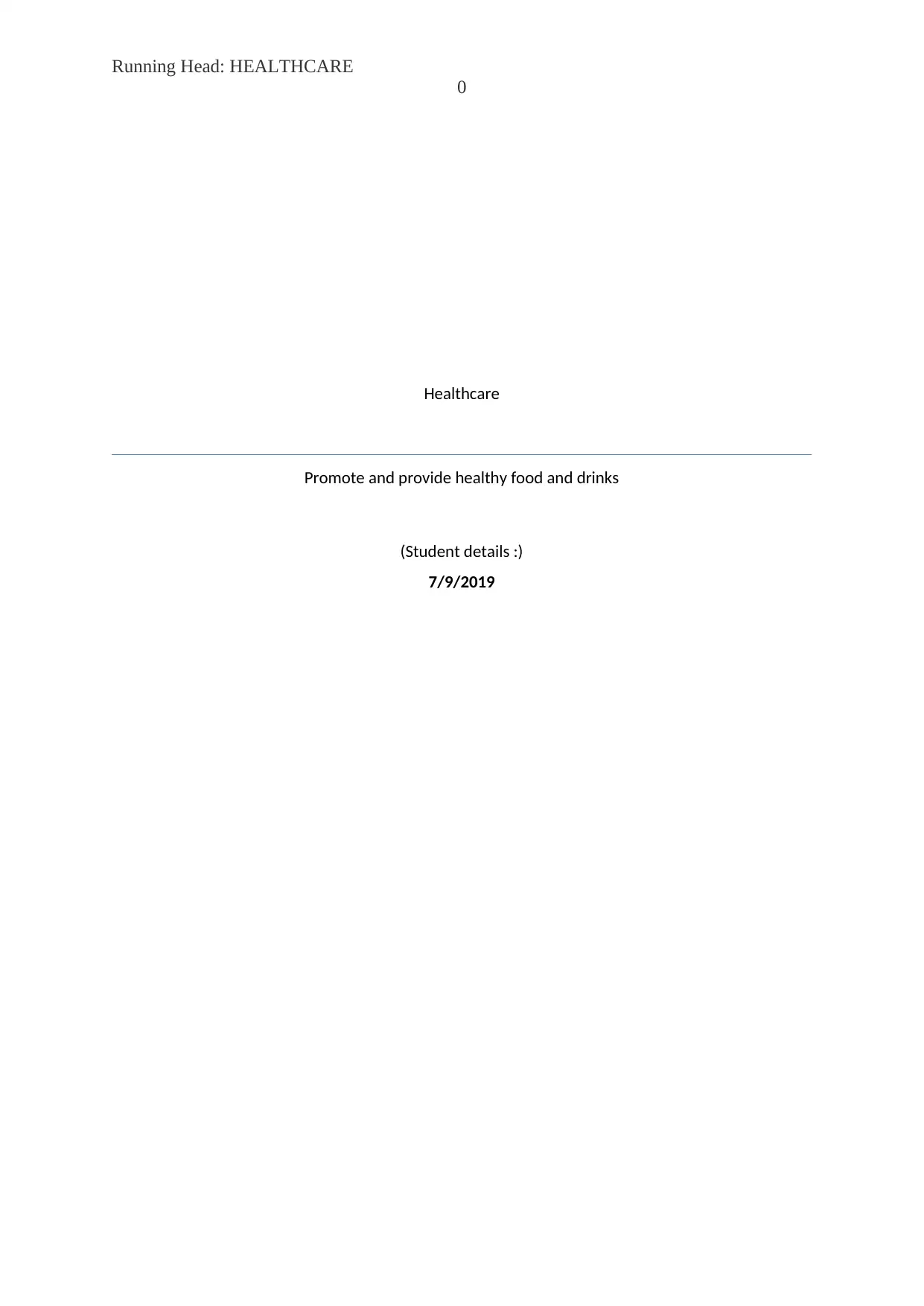
Running Head: HEALTHCARE
0
Healthcare
Promote and provide healthy food and drinks
(Student details :)
7/9/2019
0
Healthcare
Promote and provide healthy food and drinks
(Student details :)
7/9/2019
Paraphrase This Document
Need a fresh take? Get an instant paraphrase of this document with our AI Paraphraser
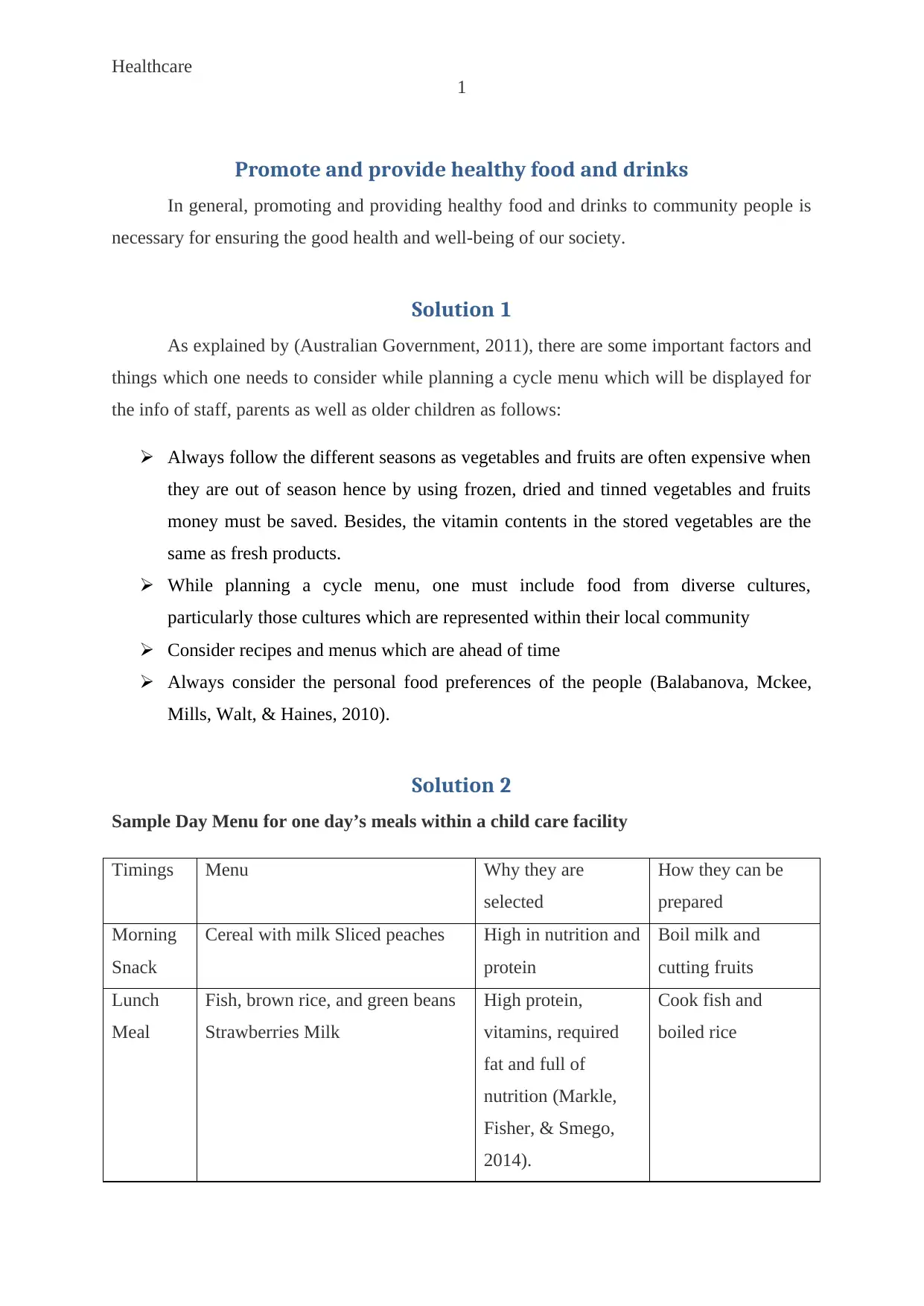
Healthcare
1
Promote and provide healthy food and drinks
In general, promoting and providing healthy food and drinks to community people is
necessary for ensuring the good health and well-being of our society.
Solution 1
As explained by (Australian Government, 2011), there are some important factors and
things which one needs to consider while planning a cycle menu which will be displayed for
the info of staff, parents as well as older children as follows:
Always follow the different seasons as vegetables and fruits are often expensive when
they are out of season hence by using frozen, dried and tinned vegetables and fruits
money must be saved. Besides, the vitamin contents in the stored vegetables are the
same as fresh products.
While planning a cycle menu, one must include food from diverse cultures,
particularly those cultures which are represented within their local community
Consider recipes and menus which are ahead of time
Always consider the personal food preferences of the people (Balabanova, Mckee,
Mills, Walt, & Haines, 2010).
Solution 2
Sample Day Menu for one day’s meals within a child care facility
Timings Menu Why they are
selected
How they can be
prepared
Morning
Snack
Cereal with milk Sliced peaches High in nutrition and
protein
Boil milk and
cutting fruits
Lunch
Meal
Fish, brown rice, and green beans
Strawberries Milk
High protein,
vitamins, required
fat and full of
nutrition (Markle,
Fisher, & Smego,
2014).
Cook fish and
boiled rice
1
Promote and provide healthy food and drinks
In general, promoting and providing healthy food and drinks to community people is
necessary for ensuring the good health and well-being of our society.
Solution 1
As explained by (Australian Government, 2011), there are some important factors and
things which one needs to consider while planning a cycle menu which will be displayed for
the info of staff, parents as well as older children as follows:
Always follow the different seasons as vegetables and fruits are often expensive when
they are out of season hence by using frozen, dried and tinned vegetables and fruits
money must be saved. Besides, the vitamin contents in the stored vegetables are the
same as fresh products.
While planning a cycle menu, one must include food from diverse cultures,
particularly those cultures which are represented within their local community
Consider recipes and menus which are ahead of time
Always consider the personal food preferences of the people (Balabanova, Mckee,
Mills, Walt, & Haines, 2010).
Solution 2
Sample Day Menu for one day’s meals within a child care facility
Timings Menu Why they are
selected
How they can be
prepared
Morning
Snack
Cereal with milk Sliced peaches High in nutrition and
protein
Boil milk and
cutting fruits
Lunch
Meal
Fish, brown rice, and green beans
Strawberries Milk
High protein,
vitamins, required
fat and full of
nutrition (Markle,
Fisher, & Smego,
2014).
Cook fish and
boiled rice
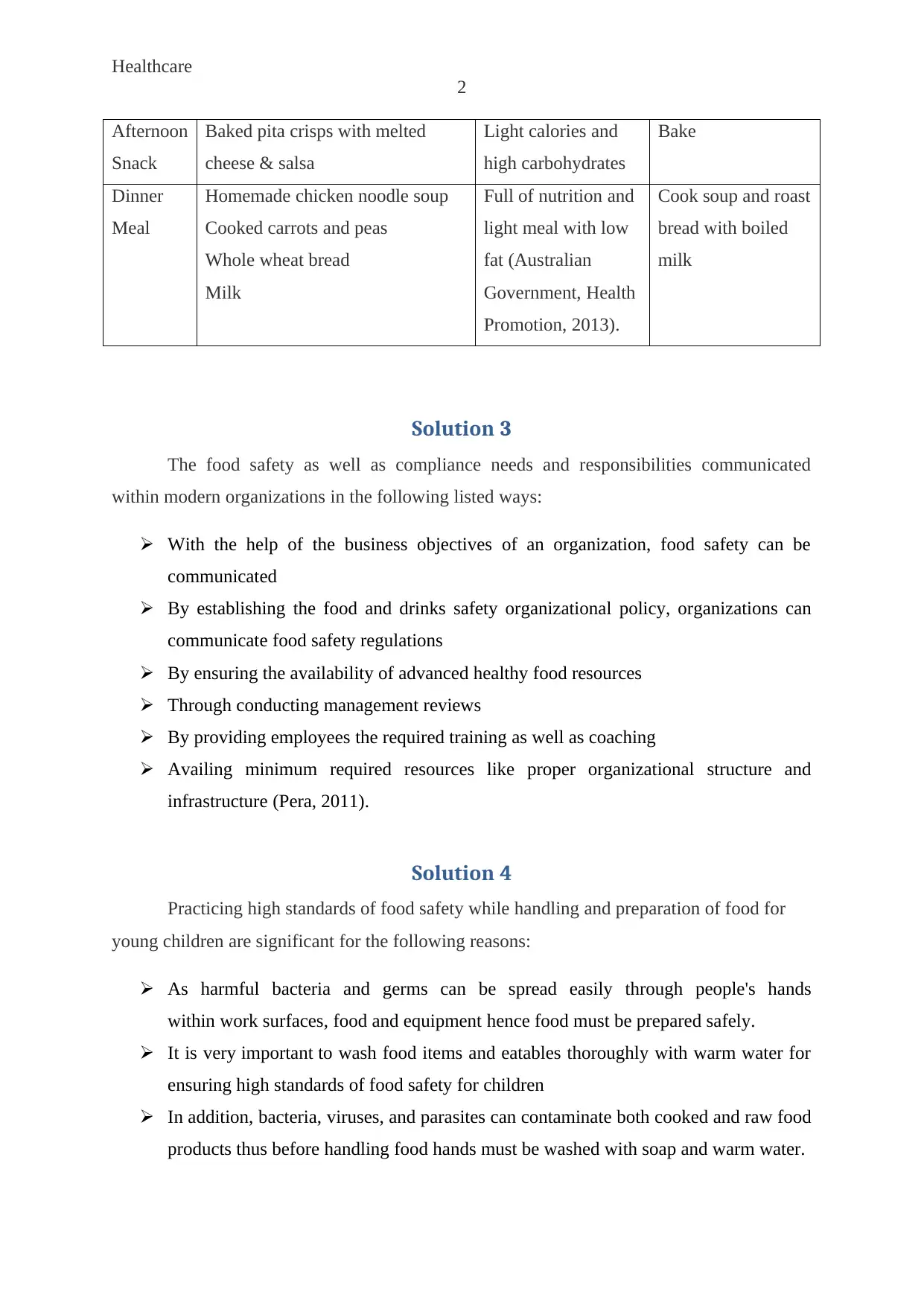
Healthcare
2
Afternoon
Snack
Baked pita crisps with melted
cheese & salsa
Light calories and
high carbohydrates
Bake
Dinner
Meal
Homemade chicken noodle soup
Cooked carrots and peas
Whole wheat bread
Milk
Full of nutrition and
light meal with low
fat (Australian
Government, Health
Promotion, 2013).
Cook soup and roast
bread with boiled
milk
Solution 3
The food safety as well as compliance needs and responsibilities communicated
within modern organizations in the following listed ways:
With the help of the business objectives of an organization, food safety can be
communicated
By establishing the food and drinks safety organizational policy, organizations can
communicate food safety regulations
By ensuring the availability of advanced healthy food resources
Through conducting management reviews
By providing employees the required training as well as coaching
Availing minimum required resources like proper organizational structure and
infrastructure (Pera, 2011).
Solution 4
Practicing high standards of food safety while handling and preparation of food for
young children are significant for the following reasons:
As harmful bacteria and germs can be spread easily through people's hands
within work surfaces, food and equipment hence food must be prepared safely.
It is very important to wash food items and eatables thoroughly with warm water for
ensuring high standards of food safety for children
In addition, bacteria, viruses, and parasites can contaminate both cooked and raw food
products thus before handling food hands must be washed with soap and warm water.
2
Afternoon
Snack
Baked pita crisps with melted
cheese & salsa
Light calories and
high carbohydrates
Bake
Dinner
Meal
Homemade chicken noodle soup
Cooked carrots and peas
Whole wheat bread
Milk
Full of nutrition and
light meal with low
fat (Australian
Government, Health
Promotion, 2013).
Cook soup and roast
bread with boiled
milk
Solution 3
The food safety as well as compliance needs and responsibilities communicated
within modern organizations in the following listed ways:
With the help of the business objectives of an organization, food safety can be
communicated
By establishing the food and drinks safety organizational policy, organizations can
communicate food safety regulations
By ensuring the availability of advanced healthy food resources
Through conducting management reviews
By providing employees the required training as well as coaching
Availing minimum required resources like proper organizational structure and
infrastructure (Pera, 2011).
Solution 4
Practicing high standards of food safety while handling and preparation of food for
young children are significant for the following reasons:
As harmful bacteria and germs can be spread easily through people's hands
within work surfaces, food and equipment hence food must be prepared safely.
It is very important to wash food items and eatables thoroughly with warm water for
ensuring high standards of food safety for children
In addition, bacteria, viruses, and parasites can contaminate both cooked and raw food
products thus before handling food hands must be washed with soap and warm water.
⊘ This is a preview!⊘
Do you want full access?
Subscribe today to unlock all pages.

Trusted by 1+ million students worldwide
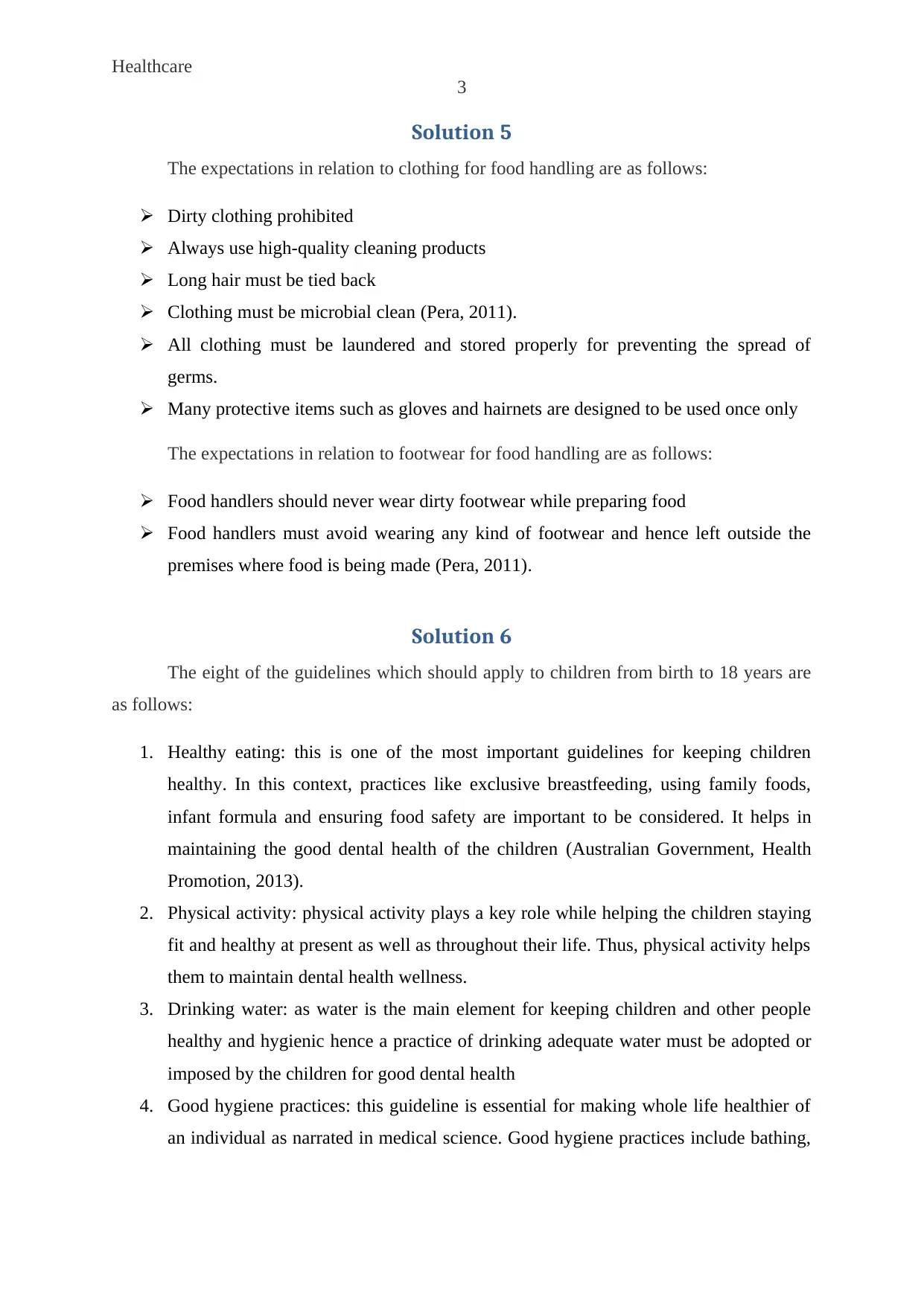
Healthcare
3
Solution 5
The expectations in relation to clothing for food handling are as follows:
Dirty clothing prohibited
Always use high-quality cleaning products
Long hair must be tied back
Clothing must be microbial clean (Pera, 2011).
All clothing must be laundered and stored properly for preventing the spread of
germs.
Many protective items such as gloves and hairnets are designed to be used once only
The expectations in relation to footwear for food handling are as follows:
Food handlers should never wear dirty footwear while preparing food
Food handlers must avoid wearing any kind of footwear and hence left outside the
premises where food is being made (Pera, 2011).
Solution 6
The eight of the guidelines which should apply to children from birth to 18 years are
as follows:
1. Healthy eating: this is one of the most important guidelines for keeping children
healthy. In this context, practices like exclusive breastfeeding, using family foods,
infant formula and ensuring food safety are important to be considered. It helps in
maintaining the good dental health of the children (Australian Government, Health
Promotion, 2013).
2. Physical activity: physical activity plays a key role while helping the children staying
fit and healthy at present as well as throughout their life. Thus, physical activity helps
them to maintain dental health wellness.
3. Drinking water: as water is the main element for keeping children and other people
healthy and hygienic hence a practice of drinking adequate water must be adopted or
imposed by the children for good dental health
4. Good hygiene practices: this guideline is essential for making whole life healthier of
an individual as narrated in medical science. Good hygiene practices include bathing,
3
Solution 5
The expectations in relation to clothing for food handling are as follows:
Dirty clothing prohibited
Always use high-quality cleaning products
Long hair must be tied back
Clothing must be microbial clean (Pera, 2011).
All clothing must be laundered and stored properly for preventing the spread of
germs.
Many protective items such as gloves and hairnets are designed to be used once only
The expectations in relation to footwear for food handling are as follows:
Food handlers should never wear dirty footwear while preparing food
Food handlers must avoid wearing any kind of footwear and hence left outside the
premises where food is being made (Pera, 2011).
Solution 6
The eight of the guidelines which should apply to children from birth to 18 years are
as follows:
1. Healthy eating: this is one of the most important guidelines for keeping children
healthy. In this context, practices like exclusive breastfeeding, using family foods,
infant formula and ensuring food safety are important to be considered. It helps in
maintaining the good dental health of the children (Australian Government, Health
Promotion, 2013).
2. Physical activity: physical activity plays a key role while helping the children staying
fit and healthy at present as well as throughout their life. Thus, physical activity helps
them to maintain dental health wellness.
3. Drinking water: as water is the main element for keeping children and other people
healthy and hygienic hence a practice of drinking adequate water must be adopted or
imposed by the children for good dental health
4. Good hygiene practices: this guideline is essential for making whole life healthier of
an individual as narrated in medical science. Good hygiene practices include bathing,
Paraphrase This Document
Need a fresh take? Get an instant paraphrase of this document with our AI Paraphraser
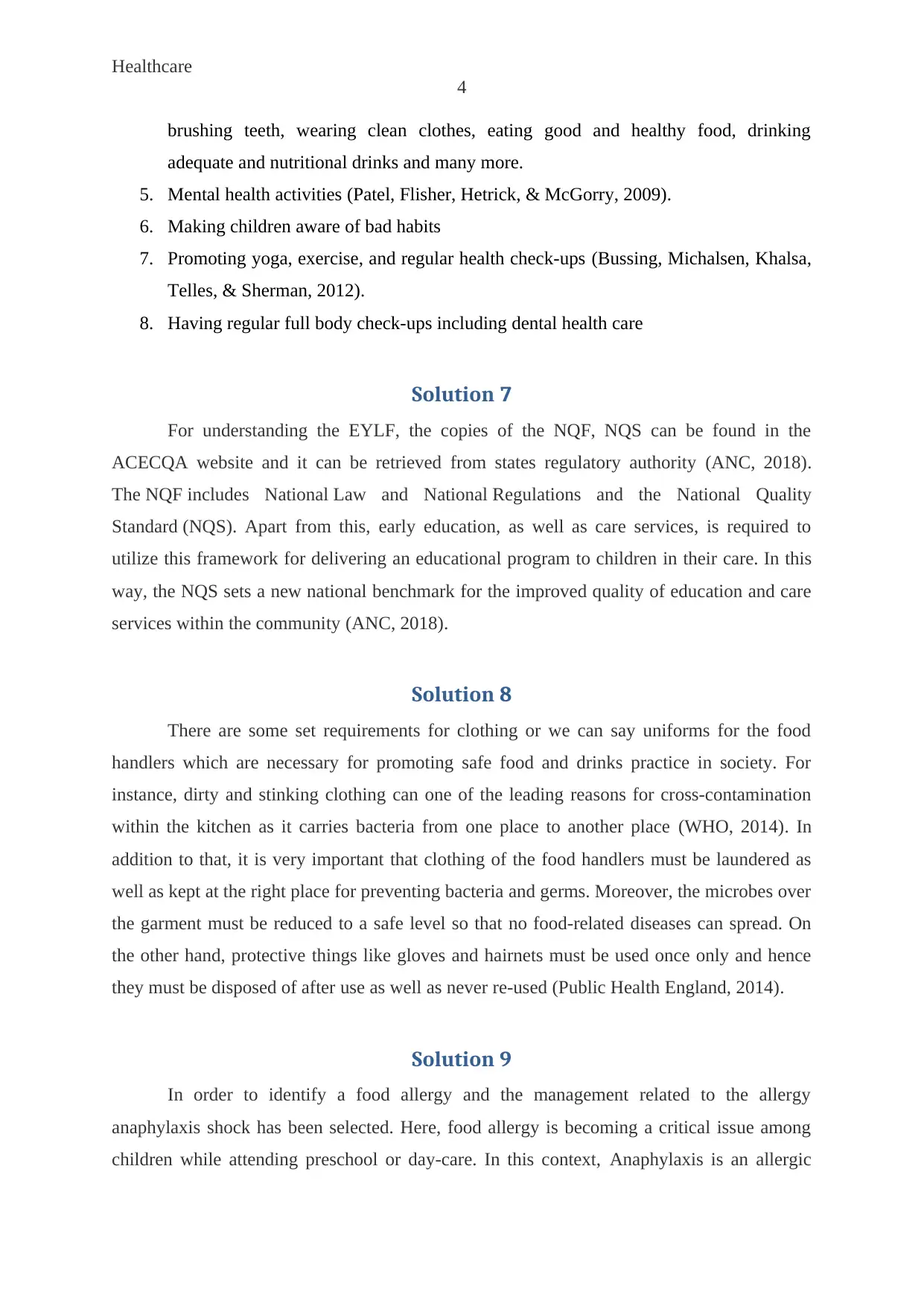
Healthcare
4
brushing teeth, wearing clean clothes, eating good and healthy food, drinking
adequate and nutritional drinks and many more.
5. Mental health activities (Patel, Flisher, Hetrick, & McGorry, 2009).
6. Making children aware of bad habits
7. Promoting yoga, exercise, and regular health check-ups (Bussing, Michalsen, Khalsa,
Telles, & Sherman, 2012).
8. Having regular full body check-ups including dental health care
Solution 7
For understanding the EYLF, the copies of the NQF, NQS can be found in the
ACECQA website and it can be retrieved from states regulatory authority (ANC, 2018).
The NQF includes National Law and National Regulations and the National Quality
Standard (NQS). Apart from this, early education, as well as care services, is required to
utilize this framework for delivering an educational program to children in their care. In this
way, the NQS sets a new national benchmark for the improved quality of education and care
services within the community (ANC, 2018).
Solution 8
There are some set requirements for clothing or we can say uniforms for the food
handlers which are necessary for promoting safe food and drinks practice in society. For
instance, dirty and stinking clothing can one of the leading reasons for cross-contamination
within the kitchen as it carries bacteria from one place to another place (WHO, 2014). In
addition to that, it is very important that clothing of the food handlers must be laundered as
well as kept at the right place for preventing bacteria and germs. Moreover, the microbes over
the garment must be reduced to a safe level so that no food-related diseases can spread. On
the other hand, protective things like gloves and hairnets must be used once only and hence
they must be disposed of after use as well as never re-used (Public Health England, 2014).
Solution 9
In order to identify a food allergy and the management related to the allergy
anaphylaxis shock has been selected. Here, food allergy is becoming a critical issue among
children while attending preschool or day-care. In this context, Anaphylaxis is an allergic
4
brushing teeth, wearing clean clothes, eating good and healthy food, drinking
adequate and nutritional drinks and many more.
5. Mental health activities (Patel, Flisher, Hetrick, & McGorry, 2009).
6. Making children aware of bad habits
7. Promoting yoga, exercise, and regular health check-ups (Bussing, Michalsen, Khalsa,
Telles, & Sherman, 2012).
8. Having regular full body check-ups including dental health care
Solution 7
For understanding the EYLF, the copies of the NQF, NQS can be found in the
ACECQA website and it can be retrieved from states regulatory authority (ANC, 2018).
The NQF includes National Law and National Regulations and the National Quality
Standard (NQS). Apart from this, early education, as well as care services, is required to
utilize this framework for delivering an educational program to children in their care. In this
way, the NQS sets a new national benchmark for the improved quality of education and care
services within the community (ANC, 2018).
Solution 8
There are some set requirements for clothing or we can say uniforms for the food
handlers which are necessary for promoting safe food and drinks practice in society. For
instance, dirty and stinking clothing can one of the leading reasons for cross-contamination
within the kitchen as it carries bacteria from one place to another place (WHO, 2014). In
addition to that, it is very important that clothing of the food handlers must be laundered as
well as kept at the right place for preventing bacteria and germs. Moreover, the microbes over
the garment must be reduced to a safe level so that no food-related diseases can spread. On
the other hand, protective things like gloves and hairnets must be used once only and hence
they must be disposed of after use as well as never re-used (Public Health England, 2014).
Solution 9
In order to identify a food allergy and the management related to the allergy
anaphylaxis shock has been selected. Here, food allergy is becoming a critical issue among
children while attending preschool or day-care. In this context, Anaphylaxis is an allergic
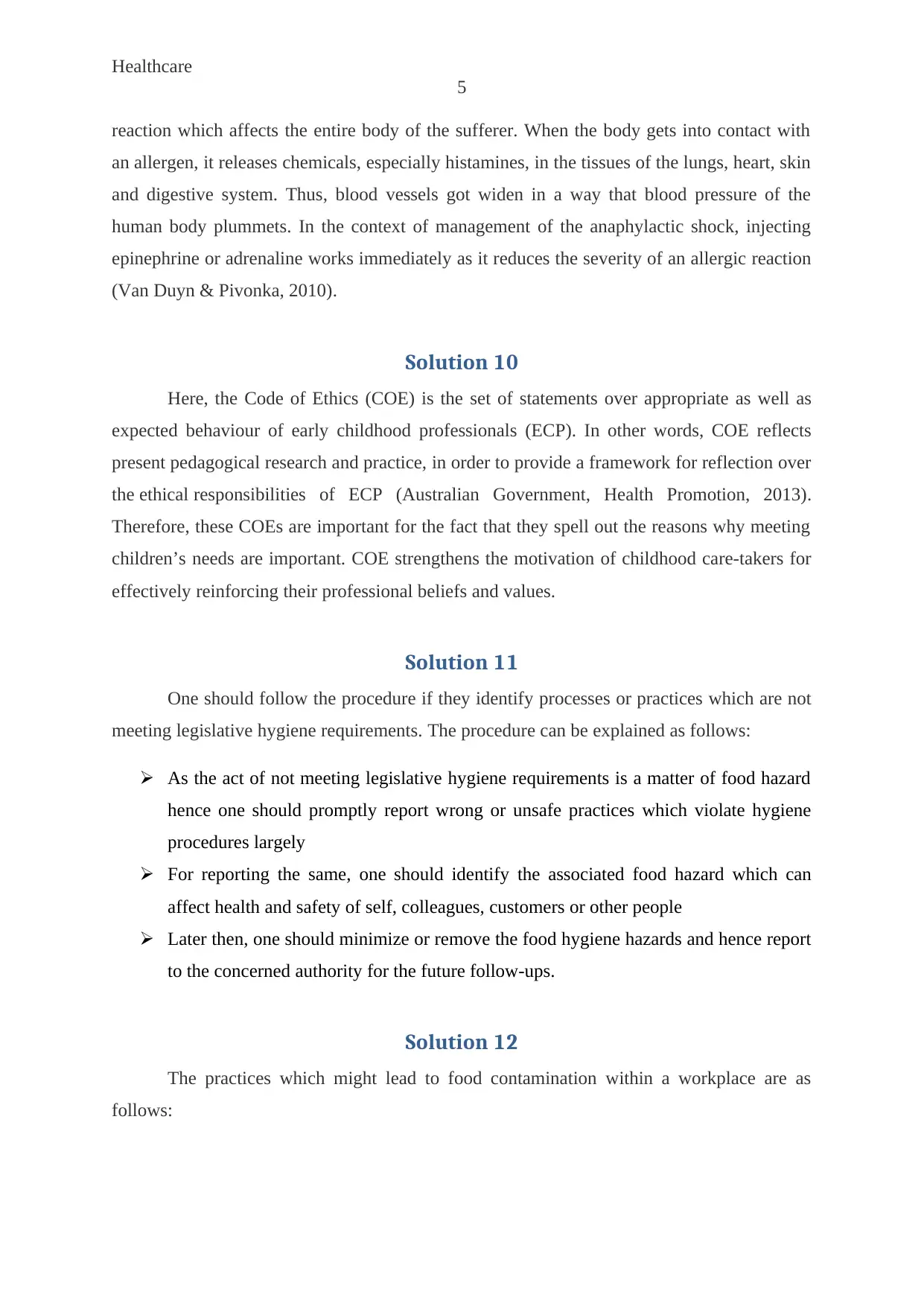
Healthcare
5
reaction which affects the entire body of the sufferer. When the body gets into contact with
an allergen, it releases chemicals, especially histamines, in the tissues of the lungs, heart, skin
and digestive system. Thus, blood vessels got widen in a way that blood pressure of the
human body plummets. In the context of management of the anaphylactic shock, injecting
epinephrine or adrenaline works immediately as it reduces the severity of an allergic reaction
(Van Duyn & Pivonka, 2010).
Solution 10
Here, the Code of Ethics (COE) is the set of statements over appropriate as well as
expected behaviour of early childhood professionals (ECP). In other words, COE reflects
present pedagogical research and practice, in order to provide a framework for reflection over
the ethical responsibilities of ECP (Australian Government, Health Promotion, 2013).
Therefore, these COEs are important for the fact that they spell out the reasons why meeting
children’s needs are important. COE strengthens the motivation of childhood care-takers for
effectively reinforcing their professional beliefs and values.
Solution 11
One should follow the procedure if they identify processes or practices which are not
meeting legislative hygiene requirements. The procedure can be explained as follows:
As the act of not meeting legislative hygiene requirements is a matter of food hazard
hence one should promptly report wrong or unsafe practices which violate hygiene
procedures largely
For reporting the same, one should identify the associated food hazard which can
affect health and safety of self, colleagues, customers or other people
Later then, one should minimize or remove the food hygiene hazards and hence report
to the concerned authority for the future follow-ups.
Solution 12
The practices which might lead to food contamination within a workplace are as
follows:
5
reaction which affects the entire body of the sufferer. When the body gets into contact with
an allergen, it releases chemicals, especially histamines, in the tissues of the lungs, heart, skin
and digestive system. Thus, blood vessels got widen in a way that blood pressure of the
human body plummets. In the context of management of the anaphylactic shock, injecting
epinephrine or adrenaline works immediately as it reduces the severity of an allergic reaction
(Van Duyn & Pivonka, 2010).
Solution 10
Here, the Code of Ethics (COE) is the set of statements over appropriate as well as
expected behaviour of early childhood professionals (ECP). In other words, COE reflects
present pedagogical research and practice, in order to provide a framework for reflection over
the ethical responsibilities of ECP (Australian Government, Health Promotion, 2013).
Therefore, these COEs are important for the fact that they spell out the reasons why meeting
children’s needs are important. COE strengthens the motivation of childhood care-takers for
effectively reinforcing their professional beliefs and values.
Solution 11
One should follow the procedure if they identify processes or practices which are not
meeting legislative hygiene requirements. The procedure can be explained as follows:
As the act of not meeting legislative hygiene requirements is a matter of food hazard
hence one should promptly report wrong or unsafe practices which violate hygiene
procedures largely
For reporting the same, one should identify the associated food hazard which can
affect health and safety of self, colleagues, customers or other people
Later then, one should minimize or remove the food hygiene hazards and hence report
to the concerned authority for the future follow-ups.
Solution 12
The practices which might lead to food contamination within a workplace are as
follows:
⊘ This is a preview!⊘
Do you want full access?
Subscribe today to unlock all pages.

Trusted by 1+ million students worldwide
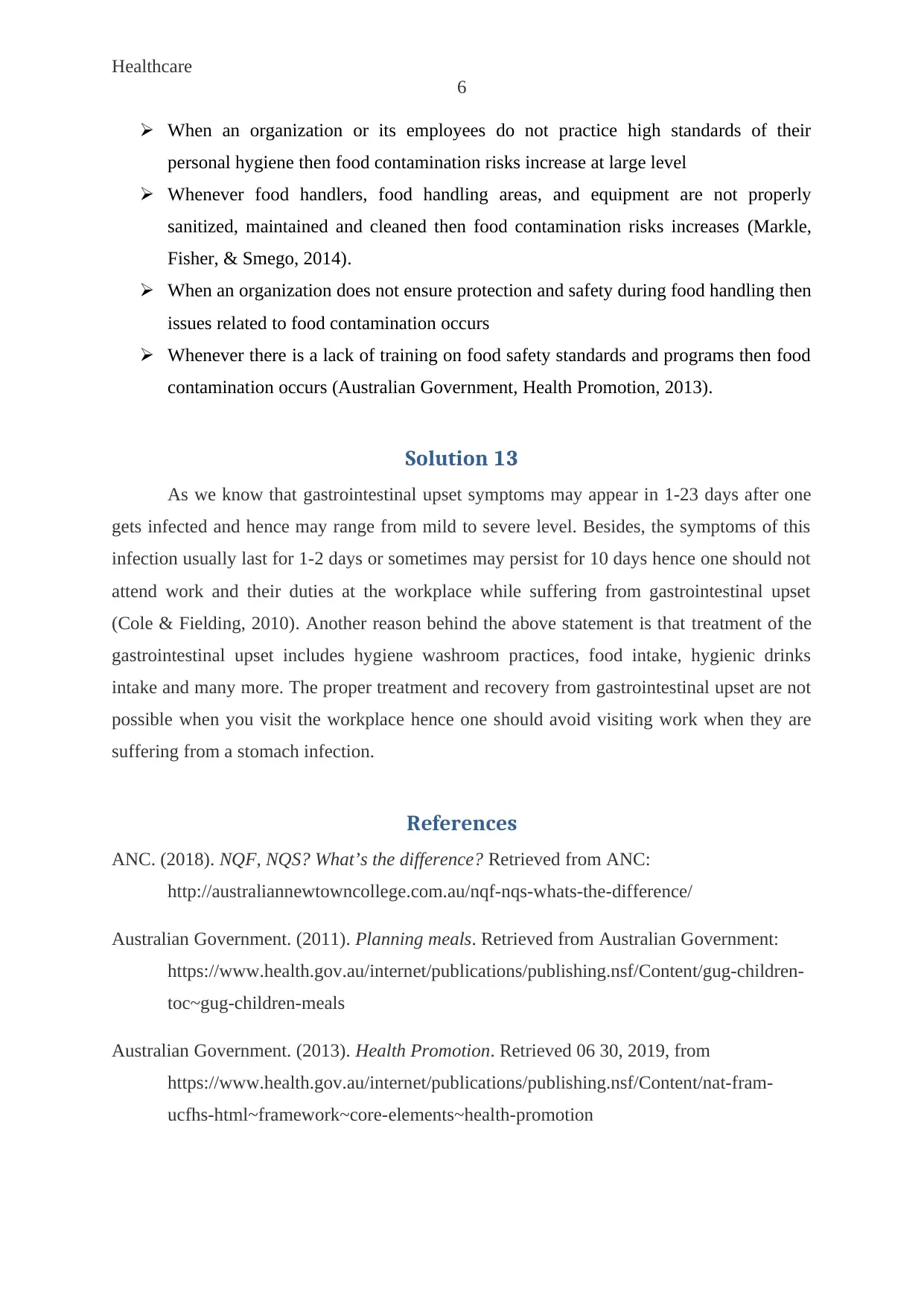
Healthcare
6
When an organization or its employees do not practice high standards of their
personal hygiene then food contamination risks increase at large level
Whenever food handlers, food handling areas, and equipment are not properly
sanitized, maintained and cleaned then food contamination risks increases (Markle,
Fisher, & Smego, 2014).
When an organization does not ensure protection and safety during food handling then
issues related to food contamination occurs
Whenever there is a lack of training on food safety standards and programs then food
contamination occurs (Australian Government, Health Promotion, 2013).
Solution 13
As we know that gastrointestinal upset symptoms may appear in 1-23 days after one
gets infected and hence may range from mild to severe level. Besides, the symptoms of this
infection usually last for 1-2 days or sometimes may persist for 10 days hence one should not
attend work and their duties at the workplace while suffering from gastrointestinal upset
(Cole & Fielding, 2010). Another reason behind the above statement is that treatment of the
gastrointestinal upset includes hygiene washroom practices, food intake, hygienic drinks
intake and many more. The proper treatment and recovery from gastrointestinal upset are not
possible when you visit the workplace hence one should avoid visiting work when they are
suffering from a stomach infection.
References
ANC. (2018). NQF, NQS? What’s the difference? Retrieved from ANC:
http://australiannewtowncollege.com.au/nqf-nqs-whats-the-difference/
Australian Government. (2011). Planning meals. Retrieved from Australian Government:
https://www.health.gov.au/internet/publications/publishing.nsf/Content/gug-children-
toc~gug-children-meals
Australian Government. (2013). Health Promotion. Retrieved 06 30, 2019, from
https://www.health.gov.au/internet/publications/publishing.nsf/Content/nat-fram-
ucfhs-html~framework~core-elements~health-promotion
6
When an organization or its employees do not practice high standards of their
personal hygiene then food contamination risks increase at large level
Whenever food handlers, food handling areas, and equipment are not properly
sanitized, maintained and cleaned then food contamination risks increases (Markle,
Fisher, & Smego, 2014).
When an organization does not ensure protection and safety during food handling then
issues related to food contamination occurs
Whenever there is a lack of training on food safety standards and programs then food
contamination occurs (Australian Government, Health Promotion, 2013).
Solution 13
As we know that gastrointestinal upset symptoms may appear in 1-23 days after one
gets infected and hence may range from mild to severe level. Besides, the symptoms of this
infection usually last for 1-2 days or sometimes may persist for 10 days hence one should not
attend work and their duties at the workplace while suffering from gastrointestinal upset
(Cole & Fielding, 2010). Another reason behind the above statement is that treatment of the
gastrointestinal upset includes hygiene washroom practices, food intake, hygienic drinks
intake and many more. The proper treatment and recovery from gastrointestinal upset are not
possible when you visit the workplace hence one should avoid visiting work when they are
suffering from a stomach infection.
References
ANC. (2018). NQF, NQS? What’s the difference? Retrieved from ANC:
http://australiannewtowncollege.com.au/nqf-nqs-whats-the-difference/
Australian Government. (2011). Planning meals. Retrieved from Australian Government:
https://www.health.gov.au/internet/publications/publishing.nsf/Content/gug-children-
toc~gug-children-meals
Australian Government. (2013). Health Promotion. Retrieved 06 30, 2019, from
https://www.health.gov.au/internet/publications/publishing.nsf/Content/nat-fram-
ucfhs-html~framework~core-elements~health-promotion
Paraphrase This Document
Need a fresh take? Get an instant paraphrase of this document with our AI Paraphraser
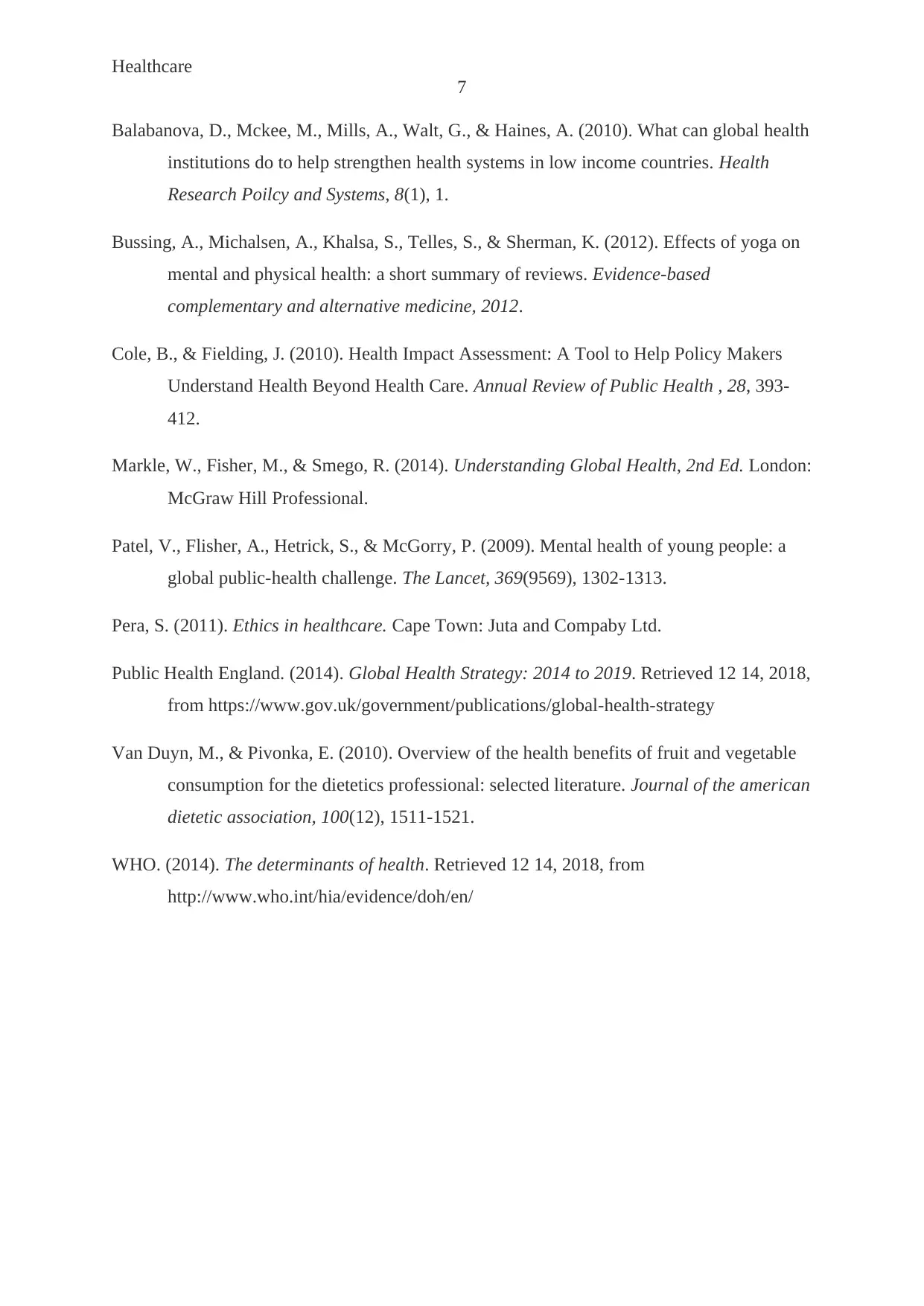
Healthcare
7
Balabanova, D., Mckee, M., Mills, A., Walt, G., & Haines, A. (2010). What can global health
institutions do to help strengthen health systems in low income countries. Health
Research Poilcy and Systems, 8(1), 1.
Bussing, A., Michalsen, A., Khalsa, S., Telles, S., & Sherman, K. (2012). Effects of yoga on
mental and physical health: a short summary of reviews. Evidence-based
complementary and alternative medicine, 2012.
Cole, B., & Fielding, J. (2010). Health Impact Assessment: A Tool to Help Policy Makers
Understand Health Beyond Health Care. Annual Review of Public Health , 28, 393-
412.
Markle, W., Fisher, M., & Smego, R. (2014). Understanding Global Health, 2nd Ed. London:
McGraw Hill Professional.
Patel, V., Flisher, A., Hetrick, S., & McGorry, P. (2009). Mental health of young people: a
global public-health challenge. The Lancet, 369(9569), 1302-1313.
Pera, S. (2011). Ethics in healthcare. Cape Town: Juta and Compaby Ltd.
Public Health England. (2014). Global Health Strategy: 2014 to 2019. Retrieved 12 14, 2018,
from https://www.gov.uk/government/publications/global-health-strategy
Van Duyn, M., & Pivonka, E. (2010). Overview of the health benefits of fruit and vegetable
consumption for the dietetics professional: selected literature. Journal of the american
dietetic association, 100(12), 1511-1521.
WHO. (2014). The determinants of health. Retrieved 12 14, 2018, from
http://www.who.int/hia/evidence/doh/en/
7
Balabanova, D., Mckee, M., Mills, A., Walt, G., & Haines, A. (2010). What can global health
institutions do to help strengthen health systems in low income countries. Health
Research Poilcy and Systems, 8(1), 1.
Bussing, A., Michalsen, A., Khalsa, S., Telles, S., & Sherman, K. (2012). Effects of yoga on
mental and physical health: a short summary of reviews. Evidence-based
complementary and alternative medicine, 2012.
Cole, B., & Fielding, J. (2010). Health Impact Assessment: A Tool to Help Policy Makers
Understand Health Beyond Health Care. Annual Review of Public Health , 28, 393-
412.
Markle, W., Fisher, M., & Smego, R. (2014). Understanding Global Health, 2nd Ed. London:
McGraw Hill Professional.
Patel, V., Flisher, A., Hetrick, S., & McGorry, P. (2009). Mental health of young people: a
global public-health challenge. The Lancet, 369(9569), 1302-1313.
Pera, S. (2011). Ethics in healthcare. Cape Town: Juta and Compaby Ltd.
Public Health England. (2014). Global Health Strategy: 2014 to 2019. Retrieved 12 14, 2018,
from https://www.gov.uk/government/publications/global-health-strategy
Van Duyn, M., & Pivonka, E. (2010). Overview of the health benefits of fruit and vegetable
consumption for the dietetics professional: selected literature. Journal of the american
dietetic association, 100(12), 1511-1521.
WHO. (2014). The determinants of health. Retrieved 12 14, 2018, from
http://www.who.int/hia/evidence/doh/en/
1 out of 8
Related Documents
Your All-in-One AI-Powered Toolkit for Academic Success.
+13062052269
info@desklib.com
Available 24*7 on WhatsApp / Email
![[object Object]](/_next/static/media/star-bottom.7253800d.svg)
Unlock your academic potential
Copyright © 2020–2025 A2Z Services. All Rights Reserved. Developed and managed by ZUCOL.





